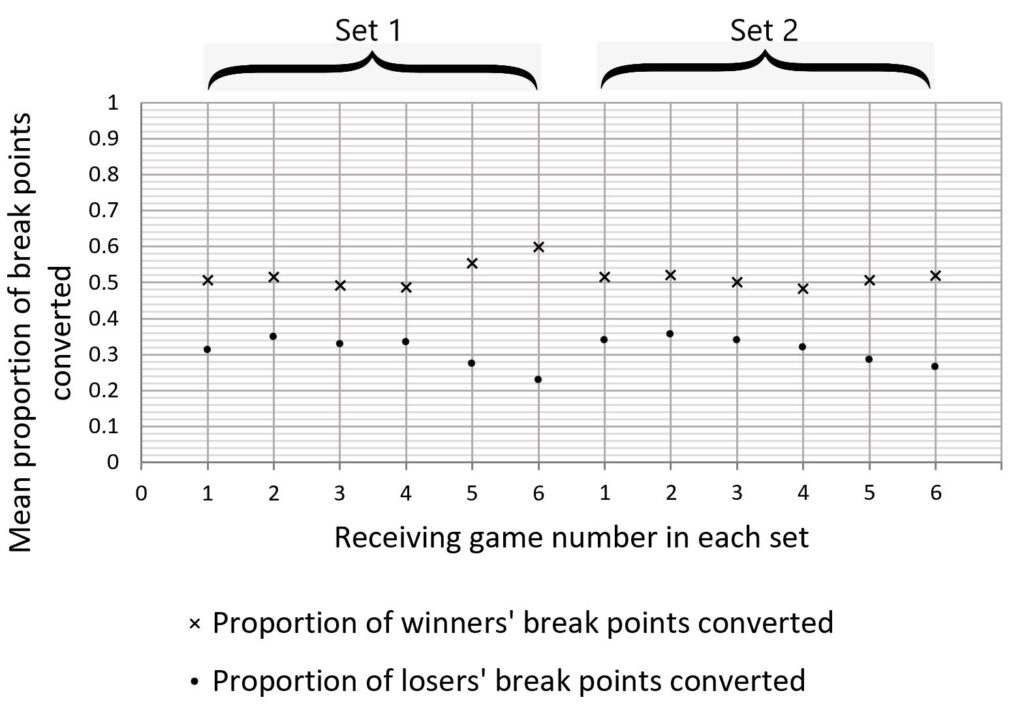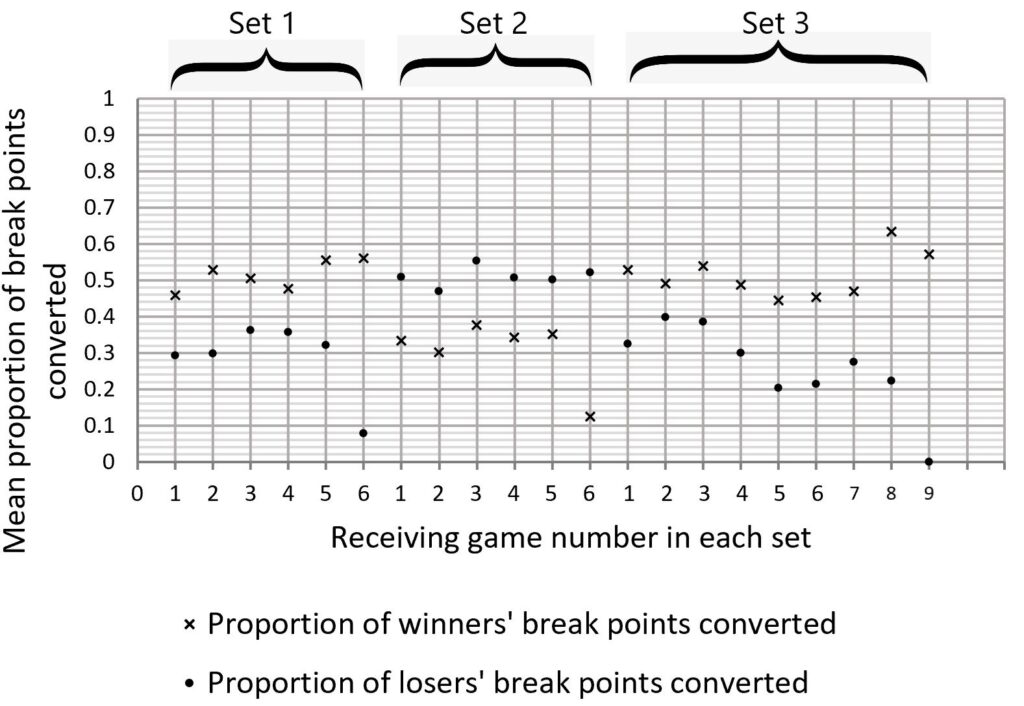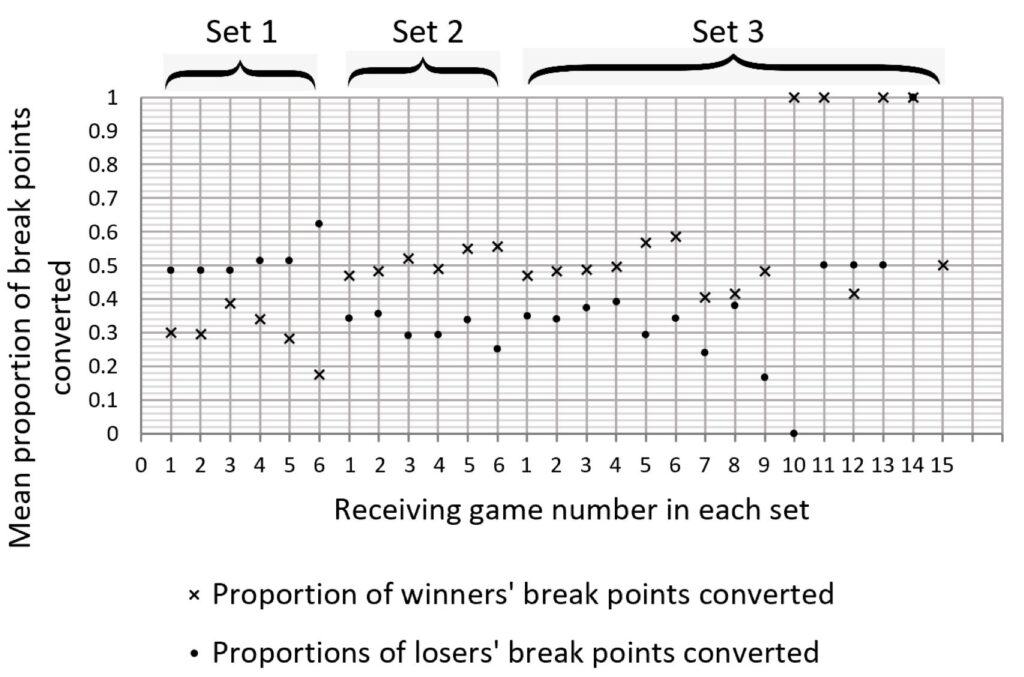The impact of converting break points on match success in elite female tennis players
ABSTRACT
The impact of break points on winning in tennis singles was investigated using data from The Championships, Wimbledon from 2004 to 2019. Break points are critical moments in a match because they can change the momentum of the game and therefore influence the outcome of the set. Understanding the pattern of break points could prove useful in informing players and coaches about the most advantageous offense strategy and psychological mindset. As expected, the winners of a set had a higher mean proportion of converted break points in that set than the losers. The difference between the mean proportions of the winners and that of the losers became most prominent in the last few games of a set, particularly where sets are closely fought and extend beyond the minimum number of games to win. The results of this study support that break points are critical moments in a match.
INTRODUCTION.
The Wimbledon Championships is the oldest tennis tournament in the world. It is the only Grand Slam event played on grass courts, the traditional playing surface in tennis. The scores and statistics have been collected at Wimbledon since 1990 and the data from 2004 to 2019 has been used in this research. As it is one of the most prestigious tournaments in tennis, the players will feel a lot of pressure to perform well and therefore may be more heavily impacted by the win or loss of a break point.
In a tennis match, there are moments that are more decisive for the match result than other moments, called ‘critical moments’ [1]. Nowadays, the serve speed of female tennis players ranges from 110 to 190 km/h [2] and the serve is the only shot a player can fully control in tennis as it is a closed skill with no external influences. Therefore, the server of a game has the advantage, and it would be expected that the server wins the game. This has been statistically proven; the probability of the server winning the game is 80.8% for men and 63.4% for women in singles championships at Wimbledon from 1992 to 1995 [3]. If the receiver has the opportunity to win the game over the server, it is known as a break point. If the receiver wins the break point, and ‘breaks’ the opponent’s serve, this will result in them winning the game. Breaks happen relatively infrequently but are pivotal in the outcome of the match [1]. A break point represents an opportunity to disrupt an opponent’s flow and completely shift the momentum of a match. As a ‘break’ has a psychological impact on both players [4], i.e. it could offer a huge psychological and tactical advantage to the receiver and on the other hand, bring a disadvantage to the server.
Psychological pressure can be influenced by factors including performance-contingent rewards, competition, ego relevance and audience observation [5]. The player’s ongoing evaluation of the costs of failure and their probability of failure leads to anxiety, which can negatively affect the performance of the player who lost their serving game. Mental toughness is a player’s ability to cope with psychological pressures and play to the best of their ability [1]. It is a decisive factor in critical moments, like at break points, because when a match is at a crucial moment, psychological pressure causes greater disruption to both players [5].
Although all players are aware of both the winning and losing outcome of a tennis match, mentally tough players are thought to play with more freedom and courage, which enables them to win more easily. Dares and Eriksson stated in their research that mentally tough players dare to play their game to the fullest as they know that it will give them the best chance of winning [1]. They concluded that mentally tough players handle breaks of their own serving game better as the server than a less mentally tough player.
The purpose of this study was to investigate the impact of break points at different moments in a set in Ladies’ Singles matches at The Championships, Wimbledon.
MATERIALS AND METHODS.
Sample.
This study used The Championships’ data taken from the Wimbledon Information System from The Championship’s female singles competitions from 2004 to 2019. Permission was granted by the All England Lawn Tennis Club, hosts of Wimbledon.
A total of 30850 break points from 2024 matches were selected for this study on the basis that they included the following performance information: number of sets in the match, set number, which player won the match, the player serving, and the game scores of both players. The data were split into four categories outlined in Table 1.
| Table 1. Total number of break points analysed, number of break points won by winner and that by losers included in this study for each set for female singles matches at The Championships, Wimbledon 2004-2019. | ||||
| Group | Number of break points faced by winners | Number of break points faced by losers | Number of break points won by winners | Number of break points won by losers |
| Number of break points in set 1 | 8060 | 5197 | 3898 | 1906 |
| Number of break points in set 2 | 8146 | 4771 | 3963 | 1752 |
| Number of break points in set 3 | 3032 | 1644 | 1481 | 552 |
Procedure
The break points were recorded in MS Excel using the data which indicated the player serving, the game scores of player 1 and player 2, the set scores of player 1 and player 2 and the set number. To determine whether a break point was won or not, logic functions were used to return a “win” if the next game scores are reset to zero. Using pivot tables, the total number of break points converted, and the total number of break points faced by winners of the matches and that by losers of the matches in each game in each set, were found. The mean proportions of break points won by the winners and that by the losers were calculated by dividing the number of converted break points of the players by the total number of break points those players faced. The mean proportions were then categorized by the type of match they came from: matches with only two sets that were both won by the winner, matches with three sets where the second set was lost by the winner of the match, and matches with three sets where the first set was lost by the winner of the match. The receiving game number represents either of the two corresponding games in the set, for example, receiving game number one represents game number one or two and receiving game number two represents game number three or four. This is because in some matches, the winner will be receiving first, but in other matches, they will be receiving in the second game, which is still their first receiving game.
RESULTS.
In matches that were won in straight sets by the winner, the proportion of converted break points by winners is approximately 50%, with a noticeable peak in the last few games of each set. It also shows that the proportion of converted break points by losers is approximately 35%, with a noticeable decrease in the last few games of each set (Figure 1).

In matches where the winner lost the second set but won the other sets, the proportion of converted break points by winners fluctuates from 46% to 63% in the first and the last set, with a noticeable decrease to around 35% in the second set where they lost. Figure 2 also shows that the proportion of converted break points by losers fluctuates from 20% to 40% in the first and the last set, with a sharp decrease at the end of the two sets where they lost. And it is approximately 50% in the second set where they won.

In matches where the winner lost the first set but won the next two sets, the proportion of converted break points by winners ranges from 47% to 59% in the second and the last set with a sharp decrease from 39% to 17% from the middle of the first set where they lost. Figure 3 also shows that the proportion of converted break points by losers fluctuates from 40% to 16% in the second and the last set and it increases from 48% to 62% in the first set where they won. The large volume of data in this study (Table 1) has meant that there is greater confidence in the trends that have been observed. However, due to the low number of matches that extend into tiebreaks in the third set, there is less confidence in the data points that extend past 6 games received in the final set (Figure 3).

DISCUSSION.
The lack of conversion of break points by losers is likely to have contributed to those players losing the match. The higher proportion of converted break points by winners suggests that winners are more mentally tough and have the ability to stay calm and perform at their best even at critical moments like break points [3].
The minimum number of games required to win a set is six. In these sets, each player will have served and received three times. Sets that have more than six games indicate that those sets were more closely contested as the loser would have won at least one game. In sets that where the loser has won some of the games, the difference between the mean proportions of winners and losers is the widest in the last few games of those sets (Figures 1, 2 and 3). This could be because the losing player is losing confidence and giving up, or possibly making the decision to save energy in the hope of a better performance in the next set. Matches that are won in straight sets (Figure 1) show a more gradual decrease in the mean proportion of break points at the end of the sets compared with those games in sets in matches that extend for a third set (Figures 2 and 3). The winner of the set may be building confidence and gaining momentum, leading them to have a greater mean proportion of converted break points in the final few games of the set.
This research was focused on Ladies’ Singles where matches are played to the best of three sets. It would be valuable to investigate whether men have a lower proportion of converted break points as their serves are perceived to be stronger and so are harder to break [2]. There is anecdotal evidence that the player serving first in a set has a mental advantage in the set. Further research to determine whether the data supports this hypothesis would be useful to sport psychologists.
It would also be interesting to explore differences in seeding and whether higher seeded players have a mental advantage over lower seeded players. Later matches in the tournament are higher stakes because they have greater media coverage, and the prospect of sponsorships and titles. Further research on the proportion of converted break points in earlier matches versus later matches in the tournament can be done to compare the number of breaks in lower stake games and higher stake games.
CONCLUSION.
In conclusion, this study provides valuable insights into the impact of break points on winning in tennis singles, particularly in Ladies’ Singles matches at The Championships, Wimbledon from 2004 to 2019. The findings affirm the significance of break points as critical moments in a match, capable of influencing the momentum and ultimately determining the outcome of a set.
ACKNOWLEDGMENTS.
I would like to thank my teachers, Dr Clare Roper, Mrs. Catriona Coutts-Wood and Mrs. Sasha Han, for their guidance and support, the All England Lawn Tennis Club, and the Wimbledon Information System for permission to use this data.
REFERENCES.
- H. Dares, P. Eriksson, “Tennis and sports psychology: Mental toughness as a decisive factor in critical moments of elite male tennis,” thesis, University of Gymnastics and Sports, Stockholm (2023).
- E. G. Brown, A faster serve has more impact on success for female elite tennis players than males. International Journal of Performance Analysis in Sport 21 (4), 600-610 (2021).
- J. R. Magnus, F. J. G. M. Klaassen, On the Advantage of Serving First in a Tennis Set: Four Years at Wimbledon. The Statistician 48 (2), 247-256 (1999).
- P. O’Donoghue, Break points in Grand Slam men’s singles tennis. International Journal of Performance Analysis in Sport, 12 (1), 156-165 (2012).
- D. Harris, S. J. Vine, M. Eysenck, M. R. Wilson, Psychological pressure and compounded errors during elite-level tennis. Psychology of Sport and Exercise 56, e101987 (2021).
Posted by buchanle on Tuesday, April 30, 2024 in May 2024.
Tags: Grand Slam, momentum, psychology, Wimbledon

